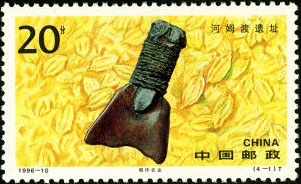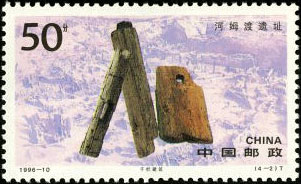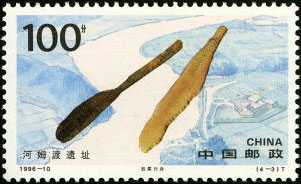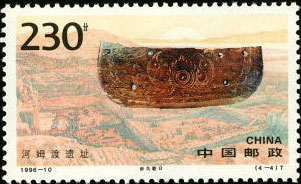1996-10, Scott 2677-80 Hemudu Ruins
Technical details
Scott No: 2677-80Serial number: 1996-10
Values in set: 4
Date of issue: May 12, 1996
Designers: Ren Yu; Dong Zuyi; Hu Xueyong
Size: 50*30mm
Perforation: 12
Sheet composition: 40
Printing process: gravure-engraving combined
Background
The Hemudu Culture, a culture formed in early Chinese Neolithic Age (7,000 to 8,000 years ago ), was discovered in Hemudu Village of Yuyao County, Zhejiang Province in 1973. The absolute period of the culture lasted form 5200 BC to 4500 BC. Houses at that time were made of wood in rod-railing type: rows of square wood and board piles were driver, on which keel plates and floor boards were put on.Using this as a base, pillars were then erected, and a roof was set on top of the pillars. Structures of tenons and mortises were found in the houses construction, and there were tongue-and-groove joints among the floor boards, representing a high level of carpentry.Meanwhile, a large number of rice husks, carbonized grains and rice straw ashes, together with the winnowing spade made of buffalo's scapula evacuated in the Hemudu Culture site show that rice planting at that time boasted of a considerable scale. The main domestic animals included buffaloes and pigs.
The stone artifacts, including axes, adzes and chippers, made during the Hemudu Culture period were rather rough, and there were quite a few of bone and wooden objects. The wooden oars, for example, were found in the ruins, showing that there was water transportation at that time .
The carbon-contained black pottery was the representative of the Hemudu pottery. With a round bottom, the pottery included cauldrons, pots, basins, earthen bowls and gridirons. Cauldrons and gridirons were the main cooking utensils. The decorative patterns on the surface of rope, seal and scratching. Some of them contains geometric figures, others were descriptive drawings, depicting swimming fish, fat pigs and ripe rice. Also found in the ruins were some color pottery. In fact they were black pottery covered with a gray clothing, and decorated with dark black designs.
In 1982, the State Council enlisted the Hemudu Culture Relics as one of the key culture relics under State protection, and in 1993, the Hemudu Culture Relics Museum was founded.
Price List
Item location: China
Ships to: Worldwide
*Shipping (via registered air mail) is based on subtotal of order. See detials below.
* 1) for special items shipping and handling cost may be included. 2) Other fast shipping is available.
To special order, please let us know what you are looking for. We will help you to meet your unique interests.
Ships to: Worldwide
*Shipping (via registered air mail) is based on subtotal of order. See detials below.
| Order Subtotal | S & H |
| $0.01---$15.00 | US $5.00 |
| $15.01---$50.00 | US $6.00 |
| $50.01---$100.00 | US $7.00 |
| $100.01---$180.00 | US $8.00 |
| $180.01---over | US $9.00 |
To special order, please let us know what you are looking for. We will help you to meet your unique interests.

 (4-1), Paddy Agricolture, 20 fen, 50*30mm
(4-1), Paddy Agricolture, 20 fen, 50*30mm







